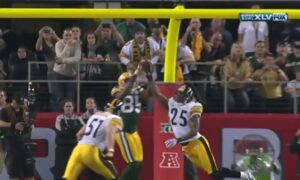By Matthew Marczi
With over a third of the Pittsburgh Steelers’ offensive and defensive starting lineups featuring new faces, the 2013 season should be interesting, if nothing else, seeing how the team renowned for its veteran presence adapts to the next generation. We have already covered seven of the eight new starters over the past two weeks, and today we conclude with perhaps the most exciting new starter, cornerback Cortez Allen.
Allen, you will remember, was drafted in 2011 in the fourth round with the idea that he would be a project due to his limited playing experience and small-school background. However, he ended up playing a bigger role amongst the team’s rookies that year than any, sans Marcus Gilbert, who was forced to start for most of the season due to Willie Colon’s injury.
He was featured most prominently in one of the team’s more memorable wins in recent years, the victory at home over the New England Patriots near the middle of the season. He saw a fair number of snaps as a dime back, primarily defending All-Pro tight end Rob Gronkowski.
Although Gronkowski recorded his share of catches and yards, his impact on the game was minimal, in contrast to his three touchdowns that he had against the Steelers the year before. The game marked the beginning of Allen’s rise, which saw him inherit the nickel back role last year.
In 2013, with Keenan Lewis departing for the New Orleans Saints after one year of starting, it is now Allen’s job to man the position that has seen a revolving door of late. Opposite Ike Taylor, who has been a mainstay for around a decade in the defensive backfield, Deshea Townsend has his run for a few years. Then Bryant McFadden had his turn in 2008.
After leaving for more money, William Gay got the opportunity to start in 2009, which proved to be more than he could handle at the time. McFadden was brought back in 2010, and the team went to the Super Bowl. In 2011, Gay overtook the starting job again, this time with Lewis coming in as the outside corner in nickel packages and Gay playing the slot.
Last year was Gay’s turn to leave, bumping Lewis into the starting lineup. And after a slow start, the former third round pick finally began to show his potential, in fact becoming arguably the team’s best defensive player in stretches.
While he failed to record an interception, he led the league with 23 passes defensed. In addition, he improved his play against the run, and turned in a highly representative performance in that regard. He also gave up just one touchdown all season while battling a number of different injuries.
Lewis performed so well, in fact, that he earned the attention of several teams around the league during free agency. While it is not clear if the Steelers were ever among those teams, it may not have mattered, since Lewis seemed dead set on returning to his home town of New Orleans, where he signed a lucrative new contract in a buyer’s market for cornerbacks.
It seemed rather peculiar that the Steelers did not appear to make a play for Lewis to retain his services after finally making good on his potential in his fourth season. After all, a couple years earlier, safety Ryan Clark was on the verge of signing with the Miami Dolphins before last minute negotiations with the Steelers brought him back to the Steel City.
Some, perhaps many, will continue to question the team’s decision not to even offer Lewis a contract (assuming that that is, indeed, the case). But the consensus seems to be that Cortez Allen’s emergence and potential is what made Lewis expendable (as opposed to the irreplaceable Taylor).
After all, Allen performed admirably at worst, and skillfully at best, when he was asked to enter the starting lineup late in the season to replace Taylor for the first few starts of his career.
Perhaps the greatest sales pitch Allen could have made came during the last two games of the year, in which he forced three fumbles and picked off a pair of passes. With Allen’s size and speed, adding the playmaking potential that Lewis lacked almost made the organization’s decision for them.
Why would they pay Lewis the big money now when they feel that they have the player on the roster already on the books that they believe is worth the next big contract at the position? You can rest assured that if Allen has a representative season in 2013, he can be looking at a healthy new contract in 2014 as he enters the final year of his rookie deal.
He will, of course, have to earn that paycheck on the field this year. However, one thing he certainly cannot be questioned for is his demeanor. Coming from a strong family background and attending a military college, he has the right makeup not just for the position, but for becoming a locker room leader, in the mold of a Heath Miller.
Taken under wing by Taylor since his rookie season, consider the 2013 season his graduate year from Swaggin’ University. His varied education in the field allows him to play in nearly any scenario, from zone to man, from outside to the slot, against big bodies and small. With professors such as Carnell Lake, Troy Polamalu, Clark, and Taylor, it may not be long before he becomes the teacher for the next crop of pupils.







